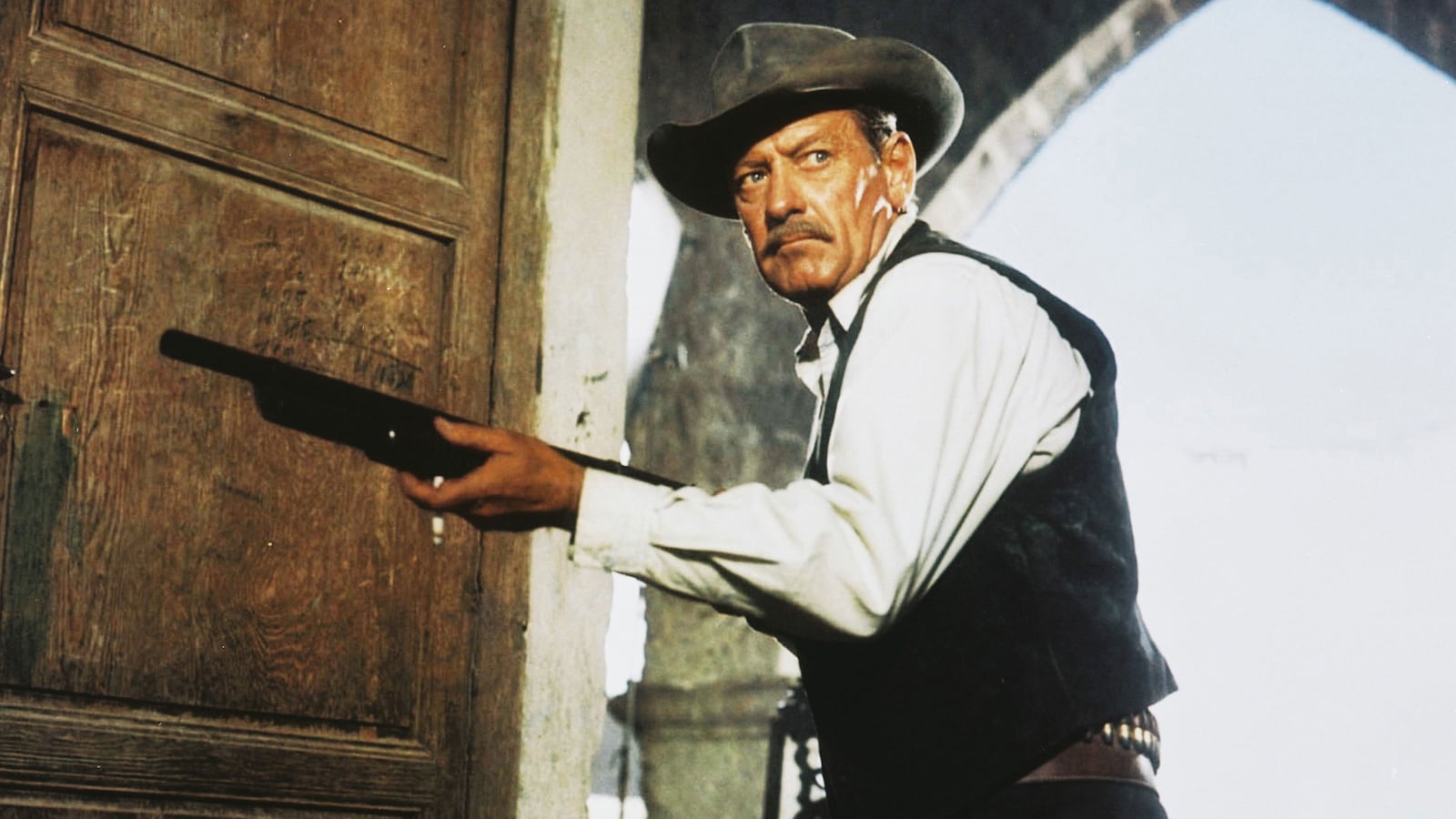The climactic shootout of The Wild Bunch lasted five hellish minutes, and after it was over, violence in the movies was never the same.
In 1968, director Sam Peckinpah took a film crew to Mexico to shoot scenes for The Wild Bunch. At the time, his reputation in Hollywood was pretty much shot. He had enjoyed early success as a writer and director in television and then with the peerless feature film Ride the High Country, which captured two of the best performances ever delivered by aging actors Joel McCrea and Randolph Scott. But then he lost control of Major Dundee, which was edited into insensibility by the studio, and fired off The Cincinnati Kid following a few days of shooting. After that, he made only one exquisite little film, a made-for-TV production of Katherine Anne Porter’s novella Noon Wine with Jason Robards. So The Wild Bunch, a big-budget theatrical release, was Peckinpah’s do-or-die chance to redeem himself and revive his career. Neither he nor anyone else knew at the time that the film would turn out to be a work of art that would radically revise our ideas about how violence is portrayed on screen. In the following story, excerpted from W.K. Stratton’s extraordinary account of the making of that movie, The Wild Bunch: Sam Peckinpah, a Revolution in Hollywood, and the Making of a Legendary Film, Peckinpah tackles the film’s climax, nicknamed “The Battle of Bloody Porch” by the crew:
Peckinpah knew he faced blowing up every cinematic barrier to the portrayal of violent death with the climactic upcoming scenes. Even more was at stake: Now he had to pull together all the elements of character and plot he’d been putting in place earlier in the picture. These upcoming sequences had to be the best in the movie. If not, everything he had been building up to would fall apart, as it had in Major Dundee. He had to be resolute in his resistance to any pressure from Phil Feldman or any of the Warners executives and follow through on his vision. He fretted about the mechanics of such a monumental undertaking. How would he stage what he had in mind? “He didn’t have a fucking clue of what he was going to do,” Gordon Dawson said. “It was not happening.” His producer, Feldman, saw that Peckinpah was stymied. A conference convened, including cast, crew, everyone who would be involved. Peckinpah, Coleman, and director of photography Lucien Ballard slowly, achingly slowly, hammered out details. It wore on Peckinpah, but he had support from cast and crew members who believed in his vision. One was Ernest Borgnine. One afternoon, Borgnine noticed Sam walking with his head low and said, “Sam, you look worried. What’s the matter?”
“I’m worried.”
“Worried? About what?”
“I don’t know—I hesitate about getting into this next thing, you know, with all this . . .” Sam trailed off.
“Sam, what are you worried about? You’ve got a great picture going here.” Borgnine encouraged Peckinpah to move forward heart and soul.
The Battle of Bloody Porch commences when Pike, Dutch, and the Gorches end their march. Mapache sees them and says, “Los gringos otra vez . . . What you want?” Holden says they’ve come for Angel. “You want Angel, no? All right, I am going to give it to you . . .” Angel appears, bound, beaten, bloodied, and filthy from being dragged behind an automobile, the dreaded symbol of the 20th century. Mapache mutters something about Angel’s going free as the general cuts the binding on Angel’s wrists. Then, abruptly, Mapache uses the knife to slice Angel’s throat. The wild bunch opens fire on Mapache immediately after their compañero falls dead. After that—nothing. At least for a moment. Peckinpah staged it so that for an existential moment the gang is free to walk away, because the general is dead and they cared nothing about Mapache. To walk away would have meant cheating their fate. Besides, the wild bunch loves the fighting. They are at their best in the face of hell. Dutch giggles. Pike surveys the crowd, more than a hundred people, and allows his eyes to settle on one person who represents real evil in Mexico: a German officer, a man from the nation of technocrats. Pike takes careful aim, then shoots him. The next to die is the accountant, Alfonso Arau’s Lieutenant Herrera, no doubt a symbolic choice on Sam’s part, given his feeling about executives.
All hell breaks loose after that.
Blood flowed for day after day during the Battle of Bloody Porch. Hundreds of squibs went off. Shell casings from thousands of rounds of blank ammunition wound up scattered on the desert surrounding the ancient buildings (and they are still there at the hacienda outside Parras). The images captured by Ballard and crew were more gruesome than anything ever before staged for a Western. Lilia Castillo’s character dies a particularly gruesome death—and a particularly slow one, with Pike Bishop watching her agonized demise. Special effects and makeup crew members made her up to have a particularly realistic and ugly “hole” in her from a gunshot. Once it was finished, Castillo looked down at the ersatz injury and suddenly felt nauseated—that was how genuine it looked. Peckinpah was deeply involved in the setup for that sequence, even applying stage blood himself from a squirt bottle. (The shots of Castillo’s “death” eventually had to be jettisoned by Sam and his editors as they tightened the film for release.)
Peckinpah spread gore over the bodies of actors and extras because he was attempting to do the one thing that America cinema and TV had failed to do: present violent death as something real. He was coming closer to it than any American director ever had with the Battle of Bloody Porch. A double for Borgnine on the picture had served with Patton in Europe during World War II. The man broke down in tears one day because the carnage Sam was creating for the Battle of Bloody Porch was too realistic, so much so that it evoked memories of real combat. With his dozens of squibs and gallons of fake blood, Peckinpah was inventing a new vocabulary for violence in film. It would change the movies forever.
“The phrase ‘Let’s go’—uttered as the remaining four members of the bunch make the decision to stand up for their comrade—is not merely a call for action but also a call for moral redemption,” wrote the Danish critic Kjetil Rødje. “In a familiar cinematic trope, the outlaws walk towards their deaths justified. The bunch is driven to the concluding battle by their sense of futility, and now seeks to accomplish some sense of order in the amoral universe in which they are operating. Regardless, as the scene unfolds the violence runs amok. What starts as a call for moral redemption ends in a senseless bloodbath that leaves for dead all the members of the bunch and large numbers of soldiers as well as some civilians. The resolution is, at best, partial. The final bloodbath provides no narrative closure but it still feels like a resolution: after the prolonged intensity of the battle, eventually it ends in a calming lull.”
Capturing Peckinpah’s violence run amok required intense, difficult work on the part of the crew. Remembering the filming of the scene, Gordon Dawson said: “Five or six cameras side by side, shooting the whole master shot, with various lenses, but shooting the whole thing. And moving the entire setup five feet. And then shooting it all again. And then moving it five feet, and shooting it all again… All the blood hits on the wall had to be cleaned up every time. All those people who just ran in and got shot, now we’re going to shoot it again, and they’re going to get shot again. They’ve got to come back in, in clean clothes. I don’t know. It was like five or six days this way. And then they say, ‘OK, boys, turn it around, we’re going back the other way.’”
Dawson and his squad functioned as a virtual costuming factory. A uniform that had been worn by an actor or extra wound up on his assembly line: washed, dried, stitched up, paint applied over damaged areas, some aging applied here and there, then back into action. Peckinpah needed daily all of those uniforms Dawson’s crew were refurbishing. Peckinpah “killed” everyone available during the Battle of Bloody Porch. Stuntman and actor Billy Hart told me he was “shot” at least a half dozen times. Even Chalo González got into the act, falling “dead” while costumed as a Mexican Army officer.
The cameras rolled, capturing Peckinpah’s statement on what it’s really like for large numbers of people to die violently. It was miles away from any shoot-out that Gunsmoke’s Matt Dillon ever engaged in outside the Long Branch Saloon in Dodge City. The intent was to shock and, hopefully, induce catharsis in theater audiences. Peckinpah, perhaps recalling the brutality he witnessed in China as a Marine, clearly wanted to make a statement about the effects of technology on human slaughter as well. Peckinpah had his wild bunch, armed with pump shotguns, semiautomatic pistols, and repeating rifles, situated on high ground, with relatively easy access to grenades and a machine gun. Arms of this sort were far removed from anything Billy the Kid or Wild Bill Hickok ever carried. Only four gang members were fighting dozens of Mexican soldiers, yet the wild bunch, using their high-tech weapons, as well as explosives, were able to kill Mexicans, most of whom had single-shot rifles, by the score. Finally the gang were taken down themselves, with a child killing Pike Bishop. Most of Mapache’s federal troopers who die are killed by the machine gun. It presaged what would happen years later, when the technology of killing had progressed even further, when a lone killer with an assault rifle could kill dozens of unsuspecting people in moments.
After weeks of shooting, Peckinpah had the footage he wanted, all of which would be reduced to about five minutes in the released version of The Wild Bunch. Now came the aftermath. The bounty hunters ride into Agua Verde, whooping. “This is like a big ol’ picnic!” L. Q. Jones’s character, T. C., exclaims. Buzzards have descended and watch as the bounty hunters collect their booty. Deke Thornton walks sadly among the carnage until he comes across Pike’s body. During the fighting, Pike had used a Colt Model 1911 semiautomatic, leaving his old-fashioned six- shooter, emblematic of the Old West, in its holster. Against the cackle of the scavenging bounty hunters, Deke lovingly retrieves Pike’s six-shooter and pays no mind to the modern weapon.

Excerpted from The Wild Bunch by W.K. Stratton. Copyright © W.K.Stratton, 2019. Published by Bloomsbury USA. Reprinted with permission.







